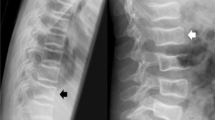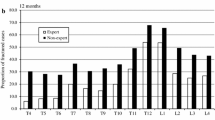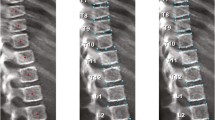Abstract
The assessment of vertebral fracture in patients with osteoporosis by conventional radiography has been improved over the past 10 years using either the semiquantitative (SQ) method devised by Genant et al. or quantitative morphometry. However, there is still no internationally agreed definition for vertebral fracture and there have been few comparative studies between these different approaches. Our study assessed the reproducibility of the SQ method and of four commonly used morphometric algorithms (Melton’s, Eastell’s, Minne’s and McCloskey’s methods) for assessing prevalent vertebral fractures, and examined the agreement of each morphometric algorithm with a SQ consensus reading performed by three experts. With this consensus reading in place of a gold standard, we determined relative measures of sensitivity, specificity and optimal cutoff threshold for each morphometric algorithm. The study was conducted in 39 postmenopausal women who had at least one osteoporotic vertebral fracture. Normal values were derived from 84 healthy postmenopausal women with apparently normal vertebral bodies. Our results indicate that the concordance of SQ method was excellent (intraobserver agreement on serial radiographs = 96.4%, κ= 0.91; agreement between individual readings and the consensus reading = 98%, κ= 0.95). Three morphometric approaches demonstrated good intra- and interobserver concordance (Melton: intraobserver agreement on serial radiographs = 92.7%, κ= 0.82, interobserver agreement = 91.1%, κ= 0.79; Eastell: intraobserver agreement on serial radiographs = 87.6%, κ= 0.66, interobserver agreement = 88.6%, κ= 0.68; McCloskey: intraobserver agreement on serial radiographs = 91.5%, κ= 0.72, interobserver agreement = 93.9%, κ= 0.78). Except for McCloskey’s method, the optimal cutoff thresholds defined in our study by highest κ score or Youden index in comparison with the SQ consensus reading were near the cutoff thresholds that were arbitrarily fixed. The four morphometric algorithms provided a good agreement with the results of the SQ consensus reading, but the more complex algorithm did not provide better results and even if we adjusted the cutoff threshold, no morphometric algorithm agreed perfectly with the SQ consensus reading. We conclude that morphometric approaches currently used should not be employed alone to detect prevalent vertebral fractures in studies on osteoporosis, but should rather be used in combination with a visual assessment. The SQ approach that allows differential diagnosis of vertebral deformities and has demonstrated a better reproducibility can be employed alone when it is performed by experienced and well-trained readers.
Similar content being viewed by others
Author information
Authors and Affiliations
Additional information
Received: 3 July 2000 / Accepted: 26 March 2001
Rights and permissions
About this article
Cite this article
Grados, F., Roux, C., de Vernejoul, M. et al. Comparison of Four Morphometric Definitions and a Semiquantitative Consensus Reading for Assessing Prevalent Vertebral Fractures . Osteoporos Int 12, 716–722 (2001). https://doi.org/10.1007/s001980170046
Published:
Issue Date:
DOI: https://doi.org/10.1007/s001980170046




